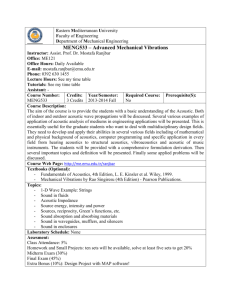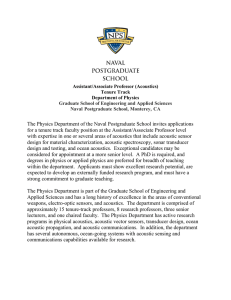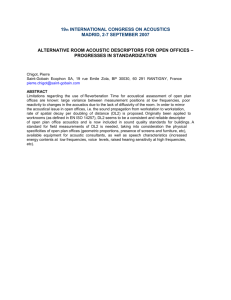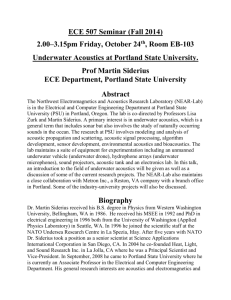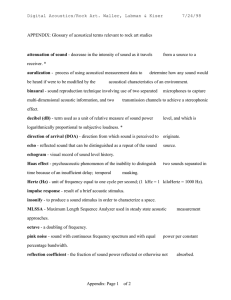Acoustical Oceanography and Shallow Water Acoustics Jim Lynch WHOI AOP&E Dept.
advertisement
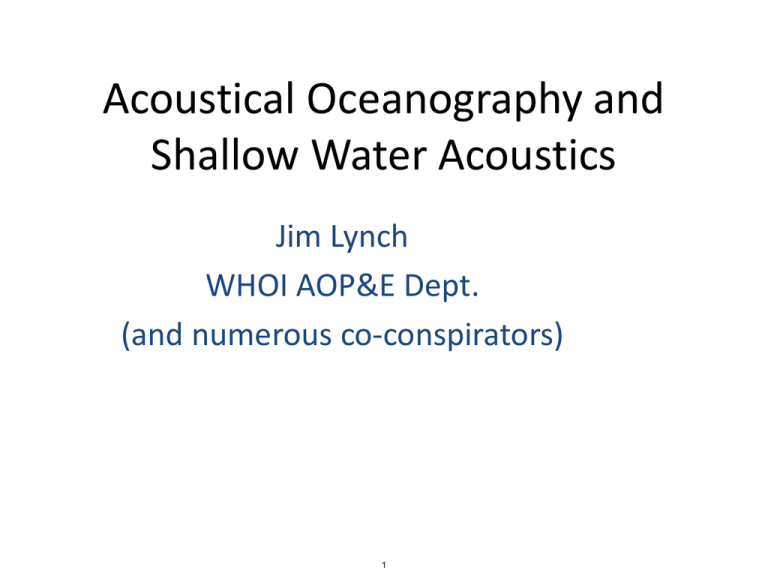
Acoustical Oceanography and Shallow Water Acoustics Jim Lynch WHOI AOP&E Dept. (and numerous co-conspirators) 1 In Honor of Walter Munk – Esteemed Colleague and Shipmate Walter’s enthusiasm, love of ocean science, and sense of fun and adventure have been infectious. These have been his gifts to his colleagues, as much as his great scientific contributions 2 Quo Vadis, SW Acoustics? Back to the Future 101 *Lets look at what bio-geo-chemicophysico-acoustico ocean science we would like to know (Must interface with acoustics). *Will stick to my own, most recent area of low-to-medium frequency SW acoustics. (10 Hz to 10 kHz, roughly) *According to Tim Duda and others, chemically induced acoustic change (from pH change aka ocean acidification) will be small, so maybe we’ll skip the “chemico.” 3 AGU vs. ASA priorities • ASA -> More Navy application, less pure ocean science • AGU -> More pure ocean science, less Navy applications • Acousticians using sound to study oceanography are sometimes naïve about ocean science questions, and create “hammers looking for a nail.” • Physical oceanographers are often not so interested in creating products useful for acoustics, either (e.g. an approximate map of internal tides/soliton fields). • The interface between the PO/acoustics communities has generally been a weak one (with a few exceptions) 4 PO science areas useful to SW acoustics • • • • Coastal SB fronts Coastal eddies Internal waves Oceanography in canyons 5 AWACS/SW06 TL Example: Horizontal Isotropy and Translational Invariance Tests TL (PMFO) @ R = 7.5 km, f=900 Hz 7.5 nmi OMAS 1 OMAS 2 SB Front Shelfbreak Front – Obj. Map TL @ R = 7.5 km, f=900 Hz TL means robustly constant except where interacting with Shelfbreak Front. SB Front 6 There’s big TL difference across a SB front? Yawn, old news. What’s new about fronts? • Motherhood - SB fronts are a critical transition zone between deep water and shallow water (acoustics). BUT • Can’t predict detailed PO yet (oceanographic structure) GIGO for acoustics for a big effect. • Our acoustics predictions are almost always Nx2D - is wrong due to 3D bottom slope and horizontal PO refraction/trapping effects • Does doing an acoustic inverse for ocean structure make sense here? (Or anywhere in SW? Will return to this question later.) 7 Coastal eddies • Turbulent process, very hard to predict realization on all scales that affect acoustics • Don’t even have a good spectral description of these features (k to -5/3 ?) • But can duct acoustics energy between eddy/filament pieces – can be a large, 3D effect * Again, can acoustics get info here? (Maybe a spectrum..?!) 8 Internal waves – especially nonlinear 9 IW Induced Coupled Propagation Gain/Loss Cases Lossy High Modes src Low Modes IW scatter PRIMER Noise Case – Net Amplification Low Modes IW scatter Lossy High Modes src Zhou Yellow Sea Case – Net Attenuation 10 11 Temporal dependence of the sound energy for different depths in intensity gradation (relative units) Shot LFM 12 3-D Sound Propagation Modeling • Acoustic Shadowing Curvature Radius: 225 km 13 Acoustic signals after matched filter and vertical mode filter Transmitted time Reduced Arrival Time (sec) 14 SW06, 9/08/06 OMAS Run, 900 Hz, OMAS 1 to DIFAR1, Lap 1 “Peak” TL vs Bearing With Mean and Distribution About the Mean, Range Corrected to 7.5km, Clock Drift Corrected and Triangulated positions TL, dB re 1m Ds=131’ Dr=200’ 900Hz, Peak, V1, DF1 15 (15log(R) Correction) Seems we are getting rather good as far as the acoustic propagation modeling of the forward problem goes. So, “are we there yet?!?” ANS: Not if our ocean input models are as simplistic as the two below. Idealized line source KdV “dnoidal” solution - Oversimplified deterministic 16 Idealized Garrett-Munk spectrum Oversimplified random medium IW PO models – What shall we do?! 1) Bite the bullet and tackle the Navier-Stokes equations in their full glory My personal opinion is that this is very cool, but acousticians might not want to wait years for a supercomputer to do Monte Carlo with this. 2) Devise some completely sleazy way of dealing with the internal wave field that the physical oceanographers will detest, but that will provide quick, useful realizations for the acousticians. 3) Learn how to better deal with the deterministic/stochastic boundary for systems which have some structure, but we’re not sure of details 17 Canyons - Submarine River Valleys (Underwater Yodeling, Anyone?!) PO – Upwelling of nutrients, formation of water masses on shelf, IW generation Geology – Major conduit for sediment transport from the coast to the deep sea Biology – Major hotspots for marine life, due to nutrients fed to critters on the bottom of the food chain, and the predators who consider them lunch Acoustics – A 3D “light pipe” ! 18 Sound “flowing downhill” Does it curve with the axis as well?! Sound crossing a real submarine canyon – Are there 3-D echoes!? Yodel-ay-hee! Sound flowing downhill – But is 2D model….hmmmm 19 A few biological science questions (Mid and LF acoustics related) • Marine mammal distribution, and its correlation to PO, chemistry, food, and acoustic noise • Marine mammal behavior, tracking •Fish schools, their shape and distribution, and their correlation with environmental variables 20 Sei, where are you? 21 Marine Geology (near surface) • Geology/morphology of canyons (shown) • Large scale surface/subsurface sediment survey (acoustic/material properties, not just layering and reflectance) • 3-D “big ‘ol ripple fields” on shelves 22 Scholte to Carey to Pierce (Tinkers to Evans to Chance ca. 2009) 23 Large ripple fields near shelf edge Lynch et al, South China Sea Serebryany et al, Sea of Japan 24 HALT!!! • WAIT! HOLD ON!! WHERE IS THE INVERSE PROBLEM STUFF AND USING ACOUSTICS FOR OCEANOGRAPHY?!?!?!? – Before you do any inverse problem for oceanography (be it bio-geo-chemophysico-acoustio), you have to identify WHAT process/feature/science question/engineering task is important to you (“frame a hypothesis”, sigh). – Also, you can’t do or even frame the inverse problem sensibly unless you have some good working knowledge of the forward problem (approx. environment) – Additionally, and I say this at the risk of treason: “Just because you can measure something acoustically, doesn’t mean you should measure it acoustically.” – Message from Brian Dushaw: The same holds true for “non-acoustically”! – Cost vs. accuracy/resolution issues make for Darwinian evolution of all measurement schemes! Know what else is out there!!!!! – Combine methods where appropriate. Observatory concepts interesting! 25 Let’s see how we would measure one of these environmental entities discussed using 2010+ technology! Use shelfbreak front as an example. • SB Fronts (scales ~7-10km, ~1day) • Lotsa science questions about their variability – let’s assume for now we have a good one lined up (e.g. propagation/stability of edge waves) • For grins, let’s specify a 50x50 km area to observe (reasonable) • Some measurement options to resolve a front and its variability are: – Seasoar/Scanfish – CTD, XBT – Glider/AUV – Tomography – Satellites (IR and altimetry) – Moorings – Combine data types (and optimize!) with data assimilating models 26 The UFC Competitors • • • • • • Tomography Satellite Oceanography Scanfish/SeaSoar AUV’s and Gliders Moorings CTD and XBT surveys 27 How well does each measurement fare? Use coastal front measurement as an example. • Seasoar/Scanfish (towed, undulating CTD’s) – Are ship based, so space-time sampling and costs are tied to ship speed and day rate (7 kts, $20K/day) – Sampling is very good in vertical (~1-3m, averaged over 1 km up-down cycle), but is ~1km along track and “lawnmower pattern” limited in spatial grid. – 7 kts 7x1.852 km/hr = 13 km/hr, 311 km/day, so get an ~10 km spaced radiator grid/day (x2 space aliased – would rather 5km interline spacing) – Can sense anything you can strap to a CTD (T,S,…) – “Cash limited” endurance for sampling (how many ship days) and weather dependent – Great pictures of ocean, overall good bang for the buck (100K=5 days) 28 How well does each measurement fare? (cont’d) • CTD - Goes deeper than towed body devices, but way too slow. Avg. speed maybe 3 kts. • XBT – Goes at max speed of ship, which is better than Scanfish, but still slow. Also, just T field measured, poor accuracy. • Satellites – IR has problem with surface layer masking fronts in summer, and altimeter has problem with variable bathymetry. But resolution (~km) and cost (cheaper than should be, as is subsidized) are reasonable. • Moorings – Would need 10x10=100 moorings to Nyquist sample (x,y) spatially. Is pricey, at (min) $10K/mooring. Vertical is OK, especially in SW. Temporally, moorings are the gold standard. Beautiful time series. Anybody have a spare MegaBuck?! 29 How well does each measurement fare? (cont’d) • Glider – Very interesting new technology. At $75K, fleet of 3-4 gliders is ballpark. Sampling is good in vertical, akin to Scanfish. Also, same along track resolution. Endurance is good, too – several weeks. BUT, speed is slow – 0.5 knot ballpark, or ~1km/hr. In 24 hours (timescale of front), only covers 24/500 of a lawnmower track, or alternatively need ~20 days for a survey. Need a fleet to be efficient. • AUV – Another intriguing newcomer. Pricier than gliders ($500K+), less endurance (~10 hours+), but are faster and can carry large and diverse payloads. At 5 kts, can cover 100/500 of a lawnmower track before needs recharging. With docking stations, could be a long-term measurement contender. 30 How well does each measurement fare? (cont’d) • Acoustic imaging (e.g.tomography) – Acoustics gets its x-y resolution from crossing paths, so lets assume 10+10 crossing paths to get 5 km resolution. N(N-1)/2 ~7 transceivers around volume. Vertical resolution is ~2 layer in SW due to acoustics and profile. Time resolution is excellent, and each snapshot is instantaneous. But gear is expensive ($100K/transceiver, since need low freq), and data analysis is tedious. So acoustics is not a winner here!!! 31 Where does this leave us?! • For looking at SB front, Scanfish, Gliders, CTD (for deeper) and moorings were by far the most effective. • If we looked at each case in detail, we would see significant differences in how effective each measurement technique is, due to the different natures and scales of the processes and features examined. • ONE SIZE DOES NOT FIT ALL! 32 Coastal Eddies (scales similar to front) • Moorings also OK • Gliders/AUV’s again good • Acoustics might be a nice tool for turbulence spectrum (not detailed structure) • Seasoar, scanfish OK, as scales are a few km 33 Internal waves (esp. nonlinear) Box 2 Solibore Simulation 0 10 20 Depth (m) 30 40 50 60 70 80 90 100 0 2 4 6 8 10 12 Range (km) 14 16 18 20 • These are HARD, since space scales go from internal tide scale (~10’s of km) down to 10’s of meters, and time scales from weeks (spring neap) to ~30 seconds! • Moreover, they have a high degree of structure, but that structure is still not predictable. • Moorings, AUV’s with HF acoustic backscatter and ADCP, and SAR seem best tools to image in 4-D • Still, nothing gets full 4-D spatial structure on all scales..this is a real challenge! 34 Oceanography (and geology) in canyons • Ship towed systems and moorings have fits here. Can do some things, but it is risky! - Geologists do tripods, cores, etc. • Satellite IR OK in winter. Altimetry ….not sure! • Acoustics (SeaBeam, backscatter, ADCP) do OK here! • I think AUV’s with acoustics on them will be the future here! – ABE has done deep valleys… why not shallow?! 35 Bottom material property survey Autonomous underwater vehicles with acoustics are able to work near bottom and cover large areas. Can implement a wide variety of acoustic bottom inverse methods. Win, place, or show very likely! Underwater Ripple Fields This is a slam dunk for advanced sidescan on an AUV….just need to do it. 36 Thar be whales, Cap’n…. • The VLA/HLA did a nice job of tracking vocalizing whales in 4-D in SW06 • The biologists are very keen on doing this • Our little SHRU’s are now being put in HLA/VLA mode…cheaper, lighter, easier to deploy 37 Fisshhhh…. Sidescan on vehicles for school imaging - has been done and is very successful LF and MF acoustics on vehicles for transmission and reverb studies Fishhooks on vehicle for sushi - just a thought 38 We’ve come a long way…. • We are now calmly looking at 3-D acoustics, very complicated areas (canyons), transient phenomena (fish schools), robotic vehicles, etc. as future possibilities in SW acoustics and the science/technology areas it interacts with! • This would have been considered close to science fiction when I started in OA in 1977. 39 It sure would be nice to work together a bit more…. Upper Left Side: Site of SWARM 95, STRATAFORM, PRIMER, CMO, SW06, and Pioneer Array…among others Lower Left Side: SW06 PO/ Acoustics Array 40 Above: Pioneer Array Concept Thank You! • To my family, who puts up with my nonsense far more than you do • To my colleagues, who put up with it more than they should • To my ONR sponsors, who have (hopefully) found a few nuggets in the work they have funded through the years • To Walter Munk, ONR, TOS, The Oceanographer of the Navy, and ASA for according me this incredibly nice award 41 42 MIT OpenCourseWare http://ocw.mit.edu 2.682 Acoustical Oceanography Spring 2012 For information about citing these materials or our Terms of Use, visit: http://ocw.mit.edu/terms.

